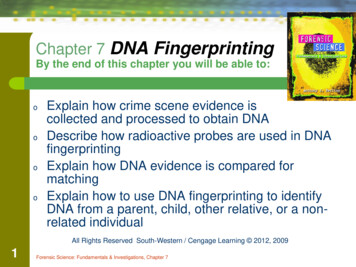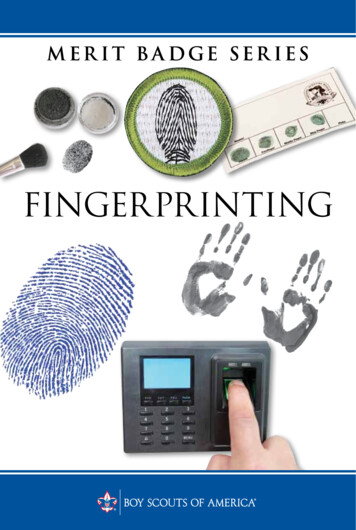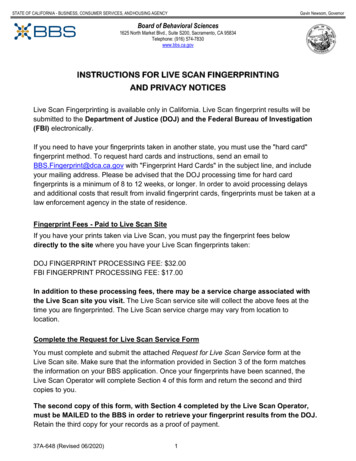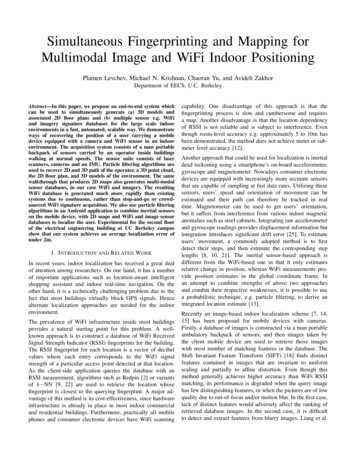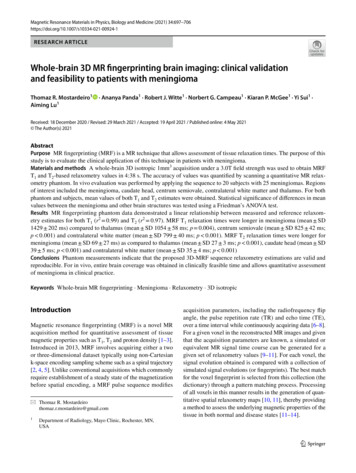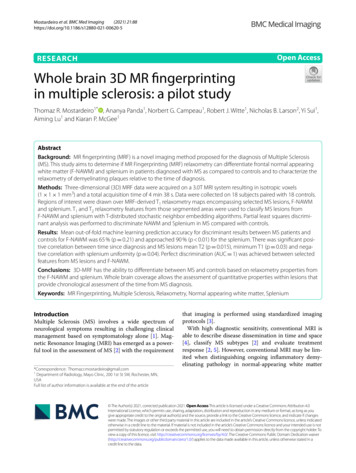
Transcription
(2021) 21:88Mostardeiro et al. BMC Med pen AccessRESEARCHWhole brain 3D MR fingerprintingin multiple sclerosis: a pilot studyThomaz R. Mostardeiro1* , Ananya Panda1, Norbert G. Campeau1, Robert J. Witte1, Nicholas B. Larson2, Yi Sui1,Aiming Lu1 and Kiaran P. McGee1AbstractBackground: MR fingerprinting (MRF) is a novel imaging method proposed for the diagnosis of Multiple Sclerosis(MS). This study aims to determine if MR Fingerprinting (MRF) relaxometry can differentiate frontal normal appearingwhite matter (F-NAWM) and splenium in patients diagnosed with MS as compared to controls and to characterize therelaxometry of demyelinating plaques relative to the time of diagnosis.Methods: Three-dimensional (3D) MRF data were acquired on a 3.0T MRI system resulting in isotropic voxels(1 1 1 mm3) and a total acquisition time of 4 min 38 s. Data were collected on 18 subjects paired with 18 controls.Regions of interest were drawn over MRF-derived T1 relaxometry maps encompassing selected MS lesions, F-NAWMand splenium. T1 and T2 relaxometry features from those segmented areas were used to classify MS lesions fromF-NAWM and splenium with T-distributed stochastic neighbor embedding algorithms. Partial least squares discriminant analysis was performed to discriminate NAWM and Splenium in MS compared with controls.Results: Mean out-of-fold machine learning prediction accuracy for discriminant results between MS patients andcontrols for F-NAWM was 65 % (p 0.21) and approached 90 % (p 0.01) for the splenium. There was significant positive correlation between time since diagnosis and MS lesions mean T2 (p 0.015), minimum T1 (p 0.03) and negative correlation with splenium uniformity (p 0.04). Perfect discrimination (AUC 1) was achieved between selectedfeatures from MS lesions and F-NAWM.Conclusions: 3D-MRF has the ability to differentiate between MS and controls based on relaxometry properties fromthe F-NAWM and splenium. Whole brain coverage allows the assessment of quantitative properties within lesions thatprovide chronological assessment of the time from MS diagnosis.Keywords: MR Fingerprinting, Multiple Sclerosis, Relaxometry, Normal appearing white matter, SpleniumIntroductionMultiple Sclerosis (MS) involves a wide spectrum ofneurological symptoms resulting in challenging clinicalmanagement based on symptomatology alone [1]. Magnetic Resonance Imaging (MRI) has emerged as a powerful tool in the assessment of MS [2] with the requirement*Correspondence: Thomaz.r.mostardeiro@gmail.com1Department of Radiology, Mayo Clinic, 200 1st St SW, Rochester, MN,USAFull list of author information is available at the end of the articlethat imaging is performed using standardized imagingprotocols [3].With high diagnostic sensitivity, conventional MRI isable to describe disease dissemination in time and space[4], classify MS subtypes [2] and evaluate treatmentresponse [2, 5]. However, conventional MRI may be limited when distinguishing ongoing inflammatory demyelinating pathology in normal-appearing white matter The Author(s) 2021, corrected publication 2021. Open Access This article is licensed under a Creative Commons Attribution 4.0International License, which permits use, sharing, adaptation, distribution and reproduction in any medium or format, as long as yougive appropriate credit to the original author(s) and the source, provide a link to the Creative Commons licence, and indicate if changeswere made. The images or other third party material in this article are included in the article’s Creative Commons licence, unless indicatedotherwise in a credit line to the material. If material is not included in the article’s Creative Commons licence and your intended use is notpermitted by statutory regulation or exceeds the permitted use, you will need to obtain permission directly from the copyright holder. Toview a copy of this licence, visit http:// creat iveco mmons. org/ licen ses/ by/4. 0/. The Creative Commons Public Domain Dedication waiver(http:// creat iveco mmons. org/ publi cdoma in/ zero/1. 0/) applies to the data made available in this article, unless otherwise stated in acredit line to the data.
Mostardeiro et al. BMC Med Imaging(2021) 21:88despite known disease processes [6] as well as functionaldisability [7].It has previously been demonstrated that MS pathologycan be described through quantitative spatial mapping ofMRI-derived relaxometry parameters, such as longitudinal (T1) and transverse ( T2) relaxation times or protondensity (PD) [8]. Further, parametric mapping may overcome the aforementioned limitations associated with MSdiagnosis and staging by improving diagnostic accuracy[6, 9, 10] and predicting patient functional impairment[11, 12].MRF is a novel MRI technique that allows quantitativemapping of T 1, T2 and PD using acquisition schemes followed by matching of the data to synthetically generatedsignals. The details of MRF have been described previously [13] and involve the repeated acquisition of imagedata over a time course in which acquisition parameterssuch as the flip angle, pulse repetition rate (TR) and echotime (TE) are intentionally modified [13]. Because theresultant time evolution of the signal in a given voxel isunique for a certain combination of tissue MR propertiessuch as PD, T1 and T2, MRF derived estimates of theseparameters are generated by comparing the signal evolution history of a given voxel to a dictionary of pre-simulated signal evolutions [14].Acquiring brain relaxometry values in clinically feasibletimes in patients with MS have been proposed with theQRAP-MASTER pulse sequence [15]. This technique hasyet to meet the requirement of being obtainable withina relatively short acquisition time and as a result hashad limited application as part of a standard, time constrained clinical MR examination. MRF has the potentialto address this time constrain and has been described asa promising classifier of MS subtypes [16] within imaging times of several minutes. However, in that work theacquisition involved only 2D data and did not providefull brain coverage, limiting the clinical use of such anapproach.The purpose of this study is to determine if MR relaxometry maps derived from a fast 3D-MRF executed aspart of a standard clinical MR examination sequence candifferentiate frontal lobe normal appearing white matter (F-NAWM) and splenium in patients with MS versushealthy volunteers based solely on MRF-based relaxometry differences. Further, we hypothesize that MRF candetect MS lesions and establish a temporal relationshipbetween relaxometry values and the time since diagnosis.Materials and methodsImage acquisition and reconstructionAll clinical data were acquired on two 3T MR scanners (Discovery MR750 and Discovery MR750W,Page 2 of 8GE Healthcare, Waukesha, WI) using an eight channel receive-only RF head coil. MRF data acquisitionwas performed using a 3D steady state free precession(SSFP) sequence with a multi-axis spiral trajectory [17].Adiabatic inversion pulses were used before each acquisition. The flip angle ramped schedule ranged from0.778 to 70 . Sequence details can be found in [17–19].The acquisition FOV was 25.6 25.6 25.6 cm3 with1mm isotropic voxel resolution. The total acquisitiontime for the whole brain volume was 4 min 38 s. The T1 range for the dictionary was from 10 to 3000 ms and T2 from 10 ms to 2000 ms. Fingerprint reconstructionand dictionary matching were performed offline usingMatlab (Mathworks, Natick, Massachusetts) on a 64bitLinux workstation equipped with two 8‐core Intel XeonGold 6244 CPU @ 3.60 GHz, 376 GB system memory,and NVIDIA Tesla V100 GPU. The reconstructionpipeline has been described elsewhere [20].Patient populationAn Institutional Review Board (IRB) approved protocolwas used to obtain MRF data in patients scheduled fora clinical MR exam. Informed consent was obtainedby all the participants. All methods were carried outin accordance with institutional guidelines and regulations. The MRF sequence was acquired during theclinical MRI prior to the administration of a gadolinium-based contrast agent. A total of 18 subjects with anestablished diagnosis of MS were included: 14 subjectshad relapsing remitting MS, 3 had secondary progressive MS and 1 had primary progressive MS. Three subjects had active gadolinium enhancing MS lesions. Inthe control group, 18 subjects were selected and pairedto age and gender for each individual with MS. Twelveof the 18 MS patients (mean age of 49 13 years(mean SD)) were female. In the control group (n 18;age mean SD age: 49 14), 12 patients were female.Time-since-diagnosis was defined as the timebetween the MRF exam and the earliest medical recordclearly stating in the medical impression the patient hadMS. To allow a better assessment of normal appearingwhite matter changes in MS, a wide range of distribution for time-since-diagnosis of MS was included. Outof the 18 subjects, 5 had been diagnosed with MS inless than 6 months. The time-since-diagnosis rangedfrom 1 to 270 months. The median time-since-diagnosis was 69 months (Percentile 25: 10 months; Percentile75: 113 months). The mean SD time-since-diagnosiswas 83 79 months. The disease activity period (timesince MS symptoms onset) largely corresponded to thetime-since-diagnosis, except for 4 subjects who had MS
Mostardeiro et al. BMC Med Imaging(2021) 21:88disease activity months (range: 18–120 months) beforethe formal diagnosis.Regions of interest analysisSegmentations were performed manually using 3D-Slicersoftware [20] as described in Fig. 1. Four to ten lesionswere selected for each patient with MS, with a total of105 lesions across 18 patients, 10 of which were activelesions. Perilesional edema was not included in the segmentation of active lesions. Additionally, for each patient,one ROI each in F-NAWM and splenium of the corpuscallosum were drawn. F-NAWM was defined as areaswithout signal changes on the standard T2 weightedimages in the clinical exam. In the control group, corresponding ROIs were drawn in the F-NAWM and splenium. First order statistics (interquartile range, skewness,uniformity, median, energy, robust mean absolute deviation, mean absolute deviation, total energy, maximum,root mean squared, 90 percentile, minimum, entropy,range, variance, 10 percentile, kurtosis, mean) obtainedfrom each ROI were analyzed. All segmentations werereviewed by a Board certified neuroradiologist.Statistical analysisDistributional characteristics of categorical variableswere summarized as counts and percentages, while quantitative values were summarized by means and standard deviations (SD) or medians and quartiles whereindicated. Given the paired nature of the study design,univariate statistical comparisons between cases andcontrols were made for all individual relaxometry features (interquartile range, skewness, uniformity, median,Fig. 1 Region of Interest segmentations within MRF maps: MRF T1relaxometry map demonstrating an active lesion in a patient withmultiple sclerosis. a Depicts the lesion [1] in the parietal white matterand the corresponding ROI. The T1 and T2 values and the first orderstatistics were simultaneously obtained from this ROI. b shows theROI over the frontal normal appearing white matter [2] and splenium[3]Page 3 of 8energy, robust mean absolute deviation, mean absolutedeviation, total energy, maximum, root mean squared,90 percentile, minimum, entropy, range, variance, 10 percentile, kurtosis, mean) using two-sided non-parametricWilcoxon signed-rank tests. Visualization of multivariate relaxometry data was performed using unsupervisedt-distributed stochastic neighbor embedding (t-SNE)dimensionality reduction based on two componentsunder default settings. These visualizations were performed separately by T1 and T2 feature set as well ascombined. Multivariate discrimination analysis betweencases and controls for F-NAWM and splenium ROIs wasperformed using a two-component multi-level sparsepartial least squares discriminant analysis (sPLS-DA)as implemented in the mixOmics R package [21]. Thesesupervised machine learning analyses used a combinedfeature set from T1 and T2 relaxometry. Discriminationperformance was characterized using area under thereceiver operating characteristic curve (AUC) based onleave-one-out cross-validation along with corresponding p-values based on Wilcoxon testing. Univariate discrimination of MS lesions from F-NAWM and spleniumusing first order statistics features of centrality (mean andmedian) was evaluated using clustered ROC analyses toaccount for intra-patient correlation. Patient-level correlation testing between T1 and T2 relaxometry values andtime since diagnosis for MS cases was performed usingthe nonparametric Kendall’s tau rank correlation test,using the mean value across lesions for a given patient.Primary analyses focused on T1 and T2 lesion means,with exploratory analyses expanded out to all regionsand feature types. All analyses were performed using thestatistical software R v3.6.2, and all reported p-values areunadjusted for multiple testing.ResultsA representative MRF-based T 1 map paired with conventional weighted imaging is shown in Fig. 2.Partial least squares discriminant analysis (PLSDA) for F-NAWM and splenium is displayed in Fig. 3.Repeated cross validation (n 5) showed mean out-offold accuracy 65 % (AUC 0.625 (p 0.21)) for discriminant results between patients and controls forF-NAWM, but mean out-of-fold accuracy approaching90 % (AUC 0.880, p 0.0001) for splenium, primarilyvia component 1. Examination of the component 1 feature loadings indicated maximum T1 value (-0.30) andT1 robust mean absolute deviation (-0.28). This wascommensurate with univariate findings, where the topassociations (Table 1) corresponded to T1 distributionalmeasures of extrema (e.g., T1 90 % percentile: Wilcoxonp 0.002) and variability (e.g., T1 Root Mean Squared:Wilcoxon p 0.003).
Mostardeiro et al. BMC Med Imaging(2021) 21:88Page 4 of 8Fig. 2 Active lesion with surrounding edema in a patient confirmed with multiple sclerosis: a depicts the lesion in the parietal white matter onMRF-based T1 map; b shows the same lesion in the same clinical exam in a T1 weighted sequence, c illustrates the typical high intensity on a T2weighted spin echo sequence, and d confirms peripheral enhancement after gadolinium injection in a T1 weighted sequence.Table 1 Most significant individual relaxometry featuresallowing differentiation between splenium and frontal normalappearing white matter in multiple sclerosisRelaxometryRegionFeaturep valueT1Splenium90 percentile0.002*T1SpleniumRoot mean squared0.003*T1SpleniumMean0.003*T1SpleniumRobust mean absolute erquartile range0.006*T1SpleniumMean absolute iformity0.012*T2Splenium90 percentile0.022**p 0.05 connotates statistical significant. Two-sided non-parametric Wilcoxonsigned-rank testsThe T-SNE Plot for classification of MS lesions is displayed on Fig. 4. AUC analysis for selected featuresdemonstrated that median and mean T1 and T2 allowedperfect discrimination (AUC 1) between splenium andlesions for both T1 and T2. Also, discrimination fromF-NAWM was excellent (AUC 1) and (AUC 0.98)using median and mean for T1 and T2, respectively. Figure 5 depicts the distribution range of mean T1 and T 2relaxometry ranges for all structures analyzed.Correlation analyses among lesion means and timesince-diagnosis for MS cases was yielded higher rankcorrelation estimates for T2 (rho 0.419, p 0.015) thanT1 (rho 0.257, p 0.11). The top five rank correlationsamong all relaxometry features and time since diagnosisare presented in Fig. 6.DiscussionThis work describes the use of a novel whole brain 3DMRF sequence [17, 18] in differentiating F-NAWM andsplenium in patients with MS based on relaxometryestimates. Given the highly reproducible and accurateinformation provided by MR relaxometry [22, 23] theresults of this study, and the isotropic whole brain coverage afforded by this technique, MRF has the potential foruse in the diagnosis of patients with MS. The previouslydescribed application of MRF in the normal brain [22,24], brain tumors [25, 26], epilepsy [27] and Parkinsondisease [28], suggests that MRF has the potential for evenbroader application beyond MS.MRI currently is a fundamental clinical tool when guiding therapy for patients with MS [29]. Given the complexity of the condition, several studies have been conductedwith more advanced MRI techniques (such as myelinwater fraction or functional MRI) to predict whetherMS could be diagnosed by machine learning techniques[30–33]. Although the mentioned investigations havebeen successful, those techniques differ from MRF in thatthey do not provide a multi parametric approach from asingle acquisition leading to lengthier exam acquisitions.Furthermore, the reproducibility of said techniques is notas well established as MRF-based relaxation estimates forboth in vivo and phantom experiments [23, 34].F-NAWM demonstrated longer relaxation in patientswith MS in our study. This has been described by otherquantitative imaging investigations [35]. Those changesare thought to be related with myelin histological changesin the white matter poorly defined by imaging [36] andimportantly could predict clinical disability [12]. In thisstudy, F-NAWM differentiation using MRF relaxationproperties between cases and controls was fairly weak(mean out of fold accuracy 65 %). Given the moderate
Mostardeiro et al. BMC Med Imaging(2021) 21:88Page 5 of 8Fig. 3 Frontal NAWM and Splenium classification for MS compared to control: Partial least squares discriminant analysis between patients (cases)and controls for splenium and frontal NAWM (normal appearing white matter) within all 18 MS patients and 18 controlsFig. 4 T-distributed stochastic neighbor embedding clustering for all segmentations: these figures demonstrate strong clustering of the data undera T-SNE algorithm, and this allows apparently perfectly discrimination between lesions and non-lesions with T1 (a) T2 (b) and combining the twoproperties (c) features. NAWM: frontal normal appearing white matter; MS: Multiple Sclerosis. The data depicted in circles refers to patients with MSand the data on square to controlssample size, it is possible larger samples could describemore robust differentiation. Also, it is important to noteprior studies [35, 37, 38] have provided estimates of theentire NAWM through the brain, potentially includingareas adjacent to MS plaques that can have subtle signalchanges. In order to avoid this pitfall, values stated inthis work were from segmented areas that only includedwhite matter with no changes in the conventional T2weighted imaging and double inversion recovery.Splenium is partially responsible for interhemisphericconnections within the brain [39]. As such, studiesdescribing splenium changes in patients with MS [40]have focused on diffusion tensor imaging. However,histological changes in MS may also be responsible forrelaxation lengthening in the splenium [35]. This couldexplain why ROI features related with a longer relaxationsuch as the percentile, mean and median were the mostimportant in the differentiation of MS from controls inour study. The accuracy described in this study for classifying disease and control at this anatomical site basedsolely on MRF-based relaxometry changes was fairlystrong ( 90 %), identifying a major advantage of MRF.Given its potential to depict changes that are currentlynot seen or described in clinical practice, MRF may beuseful, especially in those cases where the diagnosis of
Mostardeiro et al. BMC Med Imaging(2021) 21:88Page 6 of 8Fig. 5 Box and whisker plots for differences in T1 (a) and T2 (b) mean relaxation times between the structures analyzed. The vertical lines depictthe ranges, the light boxes the second quartile, the dark gray boxes the third quartile and the solid vertical line the median. For the lesions, the25th percentile (T1; T2: 1240 ms; 59 ms), median (T1;T2: 1368 ms; 67 ms), 75 percentile (T1;T2: 1509 ms; 87 ms) were higher compared to all theanatomical structures. The T1 and T2 scales are on milliseconds (ms). F-NAWM: frontal appearing normal white matterFig. 6 Visualization of the top 5 features correlated with time-since-diagnosis. The correlation was the strongest for a T2 lesion mean (rho 0.419,p 0.015), b T1 lesion minimum (rho 0.367, p 0.033), c T2 lesion root mean squared (rho 0.367, p 0.033), d T1 splenium uniformity (rho 0.354, p 0.04) and e T2 lesion median (rho 0.354, p 0.040). Multiple lesions are collapsed to a singular value via arithmetic mean
Mostardeiro et al. BMC Med Imaging(2021) 21:88MS is not clearly established by more conventional wellestablished imaging protocols.It is known that time since diagnosis in MS can influence normal tissue relaxation [7, 11, 38], and that thosechanges could predict clinical disability [41, 42]. Papadoulos et at [7] described NAWM relaxation changes ina longitudinal study covering 5 years. However, Davieset al. [11] found no significant differences in a three yearlongitudinal study after accessing T1 quantitative changesthrough NAWM and GM. In this study, T2 lengtheningwas observed in MS plaques on those patients with thelongest time from diagnosis of MS to imaging. Thesefindings could be related to a higher degree of Walleriandegeneration [43] although this finding has questionableclinical significance. Also, given this study was cross sectional, it would be valuable to investigate MRF throughthe same protocol in a longitudinal basis, so F-NAWMand splenium changes may be described and the fasteracquisition as compared with the protocols mentioned[7, 41, 42] could be a valuable tool for clinical application.Importantly, this investigation described the diagnosisof MS as the surrogate for the disease duration. As such,given the onset of MS symptoms was before the time ofthe MS diagnosis for 4 volunteers (in a selected case byseveral years), the effects of disease activity before thediagnosis were not well described by our investigation.This study has several limitations. The relatively smallsample size may not be sufficient to effectively establishF-NAWM and splenium changes in MS as compared tocontrols. Also, F-NAWM segmentations represented aminimal fraction of the overall WM in all the patientsincluded. Both active and non-active lesions wereincluded, as defined by gadolinium enhancement in conventional T1 weighted imaging, but given only 10 lesionswere active, this study was not powered to detect changeswithin relaxometry for classifying lesion activity. Futurestudies with larger sample sizes and volumetric segmentation through normal appearing white matter may beconsidered.Conclusions3D-MRF relaxation changes in the splenium and to alesser degree in the F-NAWM were able to discriminatethe presence of MS disease as compared to controls.Those findings corroborate the potential clinical role ofMRF relaxometry where suspicious white matter changesare present, as MRF could either support or counter thepresumptive diagnosis. Furthermore, quantitative evaluation of MRF derived relaxometry was helpful in characterizing the chronicity of the demyelinating lesions.Page 7 of 8AcknowledgementsThe authors would like to acknowledge the support of GE Healthcare and theUniversity of Pisa for proving the MR fingerprinting sequence and analysissoftware.Authors’ contributionsAll authors read and approved the final manuscript. TRM has made substantialcontribution to the conception, design, acquisition, analysis, interpretation ofdata, drafted the work and substantively revised it. AP has made substantialcontribution to the analysis, interpretation of data and substantively revised it.NGC has made substantial contribution to the analysis, interpretation of dataand substantively revised it. RJW has made substantial contribution to theinterpretation of data and substantively revised it. NBL has made substantialcontribution analysis, interpretation of data and substantively revised it YS hasmade substantial contribution to the conception, acquisition and substantively revised the work. AL has made substantial contribution to the conception and substantively revised it. KPM obtained institutional grant for thisresearch and has made substantial contribution to the conception, design,acquisition, analysis, interpretation of data and substantively revised it.FundingThis research was institutionally funded by the Mayo Clinic Center of Individualized Medicine at Rochester, Minnesota.Availability of data and materialsThe datasets used during the current study are available from the corresponding author on reasonable request.DeclarationsEthics approvalThis research was ethically approved by the Mayo Clinic Institutional ReviewBoard (IRB number: 19-004479) and all participants were consented toparticipate in this research. All methods were carried out in accordance withinstitutional guidelines and regulations.Consent for publicationNot applicable.Competing interestsThe authors declare that they have no competing interests.Author details1Department of Radiology, Mayo Clinic, 200 1st St SW, Rochester, MN, USA.2Department of Quantitative Health Sciences, Mayo Clinic, 200 1st St SW,Rochester, MN, USA.Received: 6 January 2021 Accepted: 19 May 2021References1. Thompson AJ, Reingold SC, Cohen JA, International Panel on Diagnosis ofMultiple S. Applying the 2017 McDonald diagnostic criteria for multiplesclerosis: authors’ reply. Lancet Neurol. 2018;17(6):499–500.2. Katz Sand I. Classification, diagnosis, and differential diagnosis of multiplesclerosis. Curr Opin Neurol. 2015;28(3):193–205.3. Csepany T. [Diagnosis of multiple sclerosis: a review of the 2017 revisionsof the McDonald criteria]. Ideggyogy Sz. 2018;71(9–10):321–9.4. Brownlee WJ, Hardy TA, Fazekas F, Miller DH. Diagnosis of multiple sclerosis: progress and challenges. Lancet. 2017;389(10076):1336–46.5. Dale RC, Pillai SC. Early relapse risk after a first CNS inflammatory demyelination episode: examining international consensus definitions. Dev MedChild Neurol. 2007;49(12):887–93.6. Lommers E, Simon J, Reuter G, Delrue G, Dive D, Degueldre C, et al.Multiparameter MRI quantification of microstructural tissue alterations inmultiple sclerosis. Neuroimage Clin. 2019;23:101879.
Mostardeiro et al. BMC Med 2.23.24.25.26.(2021) 21:88Papadopoulos K, Tozer DJ, Fisniku L, Altmann DR, Davies G, Rashid W, et al.TI-relaxation time changes over five years in relapsing-remitting multiplesclerosis. Mult Scler. 2010;16(4):427–33.Zellini F, Niepel G, Tench CR, Constantinescu CS. Hypothalamic involvement assessed by T1 relaxation time in patients with relapsing-remittingmultiple sclerosis. Mult Scler. 2009;15(12):1442–9.Krauss W, Gunnarsson M, Nilsson M, Thunberg P. Conventional andsynthetic MRI in multiple sclerosis: a comparative study. Eur Radiol.2018;28(4):1692–700.Mainero C, Louapre C, Govindarajan ST, Gianni C, Nielsen AS, Cohen-AdadJ, et al. A gradient in cortical pathology in multiple sclerosis by in vivoquantitative 7 T imaging. Brain. 2015;138(Pt 4):932–45.Davies GR, Hadjiprocopis A, Altmann DR, Chard DT, Griffin CM, Rashid W,et al. Normal-appearing grey and white matter T1 abnormality in earlyrelapsing-remitting multiple sclerosis: a longitudinal study. Mult Scler.2007;13(2):169–77.Manfredonia F, Ciccarelli O, Khaleeli Z, Tozer DJ, Sastre-Garriga J, Miller DH,et al. Normal-appearing brain t1 relaxation time predicts disability in earlyprimary progressive multiple sclerosis. Arch Neurol. 2007;64(3):411–5.Ma D, Gulani V, Seiberlich N, Liu K, Sunshine JL, Duerk JL, et al. Magneticresonance fingerprinting. Nature. 2013;495(7440):187–92.Kurzawski JW, Cencini M, Peretti L, Gomez PA, Schulte RF, Donatelli G,et al. Retrospective rigid motion correction of three-dimensional magnetic resonance fingerprinting of the human brain. Magn Reson Med.2020;84(5):2606–15.Krauss W, Gunnarsson M, Andersson T, Thunberg P. Accuracy andreproducibility of a quantitative magnetic resonance imaging method forconcurrent measurements of tissue relaxation times and proton density.Magn Reson Imaging. 2015;33(5):584–91.Nakamura K, Deshmane A, Guruprakash D, Jiang; Y, Ma; D, Lee; J, et al.A Novel Method for Quantification of Normal Appearing Brain Tissue inMultiple Sclerosis: Magnetic Resonance Fingerprinting American Academy of Neurology Meeting; 04/05/2016; San Francisco2016.Cao X, Ye H, Liao C, Li Q, He H, Zhong J. Fast 3D brain MR fingerprinting based on multi-axis spiral projection trajectory. Magn Reson Med.2019;82(1):289–301.Buonincontri G, Kurzawski JW, Kaggie JD, Matys T, Gallagher FA, CenciniM, et al. Three dimensional MRF obtains highly repeatable and reproducible multi-parametric estimations in the healthy human brain at 1.5T and3T. Neuroimage. 2021;226:117573.Gomez PA, Cencini M, Golbabaee M, Schulte RF, Pirkl C, Horvath I, et al.Rapid three-dimensional multiparametric MRI with quantitative transientstate imaging. Sci Rep. 2020;10(1):13769.Cruz G, Schneider T, Bruijnen T, Gaspar AS, Botnar RM, Prieto C. Accelerated magnetic resonance fingerprinting using soft-weighted key-hole(MRF-SOHO). PLoS One. 2018;13(8):e0201808.Rohart F, Gautier B, Singh A, KA LC. mixOmics: An R package for ‘omicsfeature selection and multiple data integration. PLoS Comput Biol.2017;13(11):e1005752.Buonincontri G, Biagi L, Retico A, Cecchi P, Cosottini M, Gallagher FA, et al.Multi-site repeatability and reproducibility of MR fingerprinting of thehealthy brain at 1.5 and 3.0T. Neuroimage. 2019;195:362–72.Korzdorfer G, Kirsch R, Liu K, Pfeuffer J, Hensel B, Jiang Y, et al. Reproducibility and repeatability of MR fin
An Institutional Review Board (IRB) approved protocol was used to obtain MRF data in patients scheduled for a clinical MR exam. Informed consent was obtained by all the participants. All methods were carried out in accordance with institutional guidelines and regu-lations. e MRF sequence was acquired during the
